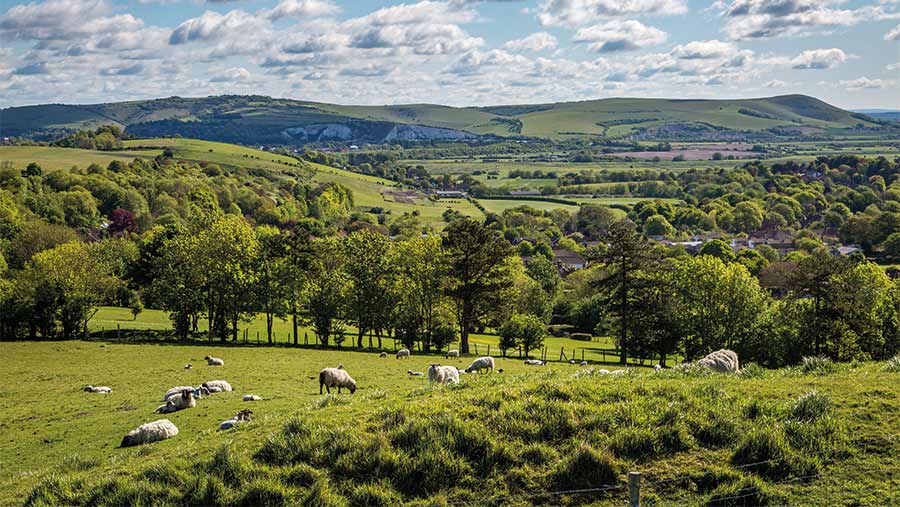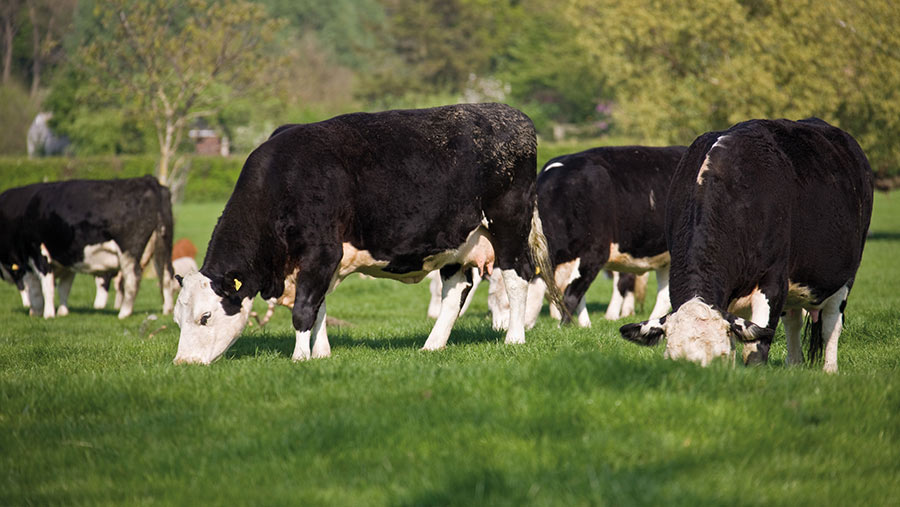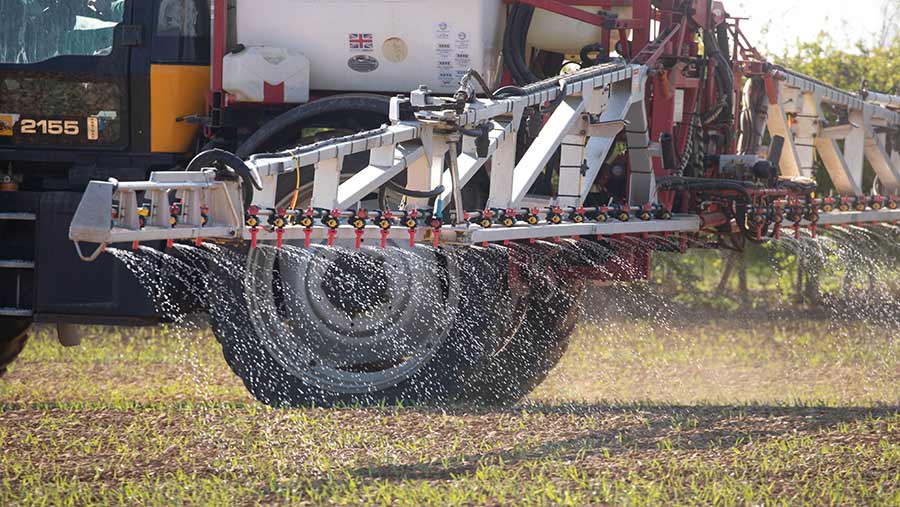Farming emissions: What they are and why they must be tackled
 © Lemanieh/Adobe Stock
© Lemanieh/Adobe Stock Farming is responsible for 11% of total UK greenhouse gas (GHG) emissions and as much as 88% of UK ammonia emissions, according to Defra’s latest Agri-climate report.
Emissions matter for several reasons – the production of GHGs such as nitrous oxide, methane and carbon dioxide is linked to global warming and climate change, while ammonia is a damaging air pollutant with harmful effects on the environment.
Air pollution is also the leading threat to public health – harmful particulates cause up to 36,000 deaths a year and it is estimated that this will cost the NHS and social care £1.6bn between 2017 and 2025.
See also: How livestock producers can cut their carbon footprint
Downward trend
Behind these headlines, Defra’s report confirms that the past 30 years has seen a downward trend for most emissions from farming, with total GHGs falling by 16% and ammonia emissions by 10%.
Much of this fall has occurred in recent years and is the result of a drop in ruminant numbers and less use of synthetic fertilisers.
Emissions from producing 1 litre of milk have fallen by 22% since the 1990s, with 11% more milk being produced from 21% fewer cows.
Likewise, the GHG emissions from producing 1kg of pork have fallen by 44%. And while nitrous oxide emissions from wheat production are unchanged, wheat yields have increased – suggesting that more wheat is being produced from the same amount of nitrogen.
Given the current emphasis on net zero, it’s not surprising that the Defra report also reveals that 64% of farmers considered it important to factor in GHGs when making farm business decisions, with 58% of them admitting to already taking action to reduce emissions.
Targets and legislation
The government has set a goal for the UK to be net zero by 2050, while the NFU has been more ambitious and committed to a date of 2040.
Other government targets include a reduction of 16% in ammonia emissions by 2030, compared with 2005 levels.
The Clean Air Strategy 2019 aimed to reduce air pollution from agriculture, offering support for farmers to invest in infrastructure and equipment to reduce emissions, and bringing in regulations on low-emission-farming methods and fertiliser use.
The Global Methane Pledge, which came from COP26 last year, saw the UK being one of the signatories to collectively cut methane emissions by 30% by 2030, on a 2020 baseline.
In addition, the Environment Act 2021 makes air quality one of four priorities, and requires government to set legally binding targets for England, with an additional target on fine particulate matter.
When it comes to ammonia emissions, large intensive pig and poultry units already have to obtain and comply with permit conditions set by the Environment Agency – something that could be extended to big dairy and intensive beef units before too long.
What are farmers already doing?
The three most common actions being taken by farmers to reduce emissions are:
- Recycling waste materials on-farm 82%
- Improving energy efficiency 78%
- Improving nitrogen fertiliser applications and efficiency 63%
Emissions types
There are three main GHGs produced from agriculture: nitrous oxide, methane and carbon dioxide.
Of these, nitrous oxide from soils and methane from livestock are the two biggest sources. Carbon dioxide from energy use contributes much less.
GHGs are presented and measured in units of carbon dioxide equivalent (CO2e), which allows comparisons to be made between them.
Carbon dioxide is the most abundant gas and is used as a benchmark.
The others are converted into CO2e by multiplying the quantity of gas emitted by the global warming potential (GWP) of that gas – its heat-absorbing ability compared to carbon dioxide.
As such, carbon dioxide has a value of 1. For methane, the value is 28 and for nitrous oxide, the value is 298.
These figures are produced when a timeframe of 100 years is used to calculate emissions of GHGs.
Some scientists believe that this method misrepresents the impact of shorter-lived GHGs, such as methane, and that a 20-year time horizon is more relevant.
Others believe that GWP should be used, as it accounts for the different properties of the gases and their impact on the climate. It also allows for the fact that methane has a shorter lifespan than the others.

© Tim Scrivener
Methane
Agriculture is responsible for 47% of the UK’s methane emissions, most of which come from livestock production via enteric fermentation.
Research has highlighted the most promising ways to reduce methane emissions from ruminants, as well as investigating their costs.
They include:
- Breeding for lower emissions animals
- Improved livestock health
- Feed additives that reduce methane production in gut bacteria
- Growing legumes in the rotation.
At the Roslin Institute, microbiome research has shown a direct correlation between the abundance of archaea in the rumen and the amount of methane produced by an animal.
It also showed that a cow’s genetics can directly affect the environment within the rumen, making it more or less hospitable for different species of micro-organism, including the methanogenic archaea.
According to Mick Watson of the University of Edinburgh’s Roslin Institute, cattle breeders are now using microbiome data in their breeding programmes to select for lower emitting animals.
“When farmers use this data in their breeding goals, together with feed additives that reduce methane emissions, there is an immediate fall in emissions.”
Feed additives show great promise and there are several options that can help to reduce methane production.
Of particular interest is Bovaer, which has been shown to give a 30% reduction in methane – or a 10-12% drop in GHG emissions for every kg of milk.
Animals lost to disease each year also have a climate and emissions impact, notes Prof Watson.
“Resources are used and methane produced. By addressing animal health, along with genetics and nutrition, the sustainability of production is improved.”
Nitrous oxide
Farming is responsible for 68% of the UK’s nitrous oxide emissions.
A very potent GHG, nitrous oxide mainly comes from fertiliser use, with 50% attributed to the manufacturing process and 50% to its use.
The gas is released during spreading and when on the field, through processes such as volatilisation, leaching and direct loss.
There are several actions that farmers can adopt to reduce their reliance on nitrogen fertiliser, says Emma Adams of the Farm Carbon Toolkit.
“Improving soil health, incorporating cover crops, widening the rotation and using organic sources of nitrogen are all helpful.”
Other actions that can help with nitrous oxide arising from fertiliser use includes the sourcing of fertiliser products – those coming from the UK or Europe usually have a lower emissions factor than product coming from China, for example.
Inhibitors, used to slow the conversion of ammonium to nitrate, have a role with urea products and help to improve nutrient use efficiency (NUE), which remains low with many granular fertiliser products.
“The standard figure for NUE from granular products is 60%,” adds Ms Adams. “Some 40% is being lost at the outset and we need to consider how to minimise these losses.”
For most, it’s about application. “Given their very high cost, it makes sense to apply fertilisers with accuracy, when the weather and plant growth is going to maximise uptake of the product.”
Carbon dioxide
Farming is responsible for just 2% of the UK’s carbon dioxide emissions, most of which come from combustion.
That puts fuel use in the spotlight, whether it’s for operating machinery, drying or heating.
Simply minimising cultivations and tracking fuel use in real-time can help, as can minimising the time that tractors spend idling.
Further ahead, the development of autonomous machines and the use of robotics offer improvements, while the development of hydrogen technologies, biomethane combustion and battery-based electric vehicles will all help to reduce emissions.
Ammonia: What’s the problem and what can be done?
Most of the ammonia produced by agriculture comes from the urine and faeces that is produced by livestock, although the spreading of manures and fertiliser also plays a part.
A natural gas, ammonia is released when animal excrement comes into contact with air, before reacting with other gases in the atmosphere to form toxic particles known as particulate matter.
Emissions are already subject to legal reduction targets – with a 16% reduction required by 2030 – and there are many steps that farmers can take to reduce ammonia emissions.
This involves focusing on losses at excretion from animals in buildings, as well as losses from manure storage and at spreading – with particular emphasis given to the spreading stage, so that the field operation doesn’t undo any good work already achieved.
“Remember that you are dealing with a gas,” says John Morgan, of Creedy Associates. “You can’t see it, so it’s possible to save it in one part of the farm, only to lose it in another.”
Diet is the first opportunity, as ammonia production is linked to the amount of protein fed to livestock.
Wherever possible, diet protein should be matched to animal requirements, which will vary with age, sex and production system.
“Supply the feed ration as it was designed,” he says. “This is important with forage, which can be variable. And avoid waste by concentrating on feed conversion efficiency.”
Extended grazing also helps, because it curtails emissions. “If you can avoid the use of yards and slurry storage, you have an advantage. Not housing livestock makes a big difference.”
A systems approach – working from a back to front view – is how he suggests farmers can get to grips with ammonia emissions.
For this reason, he highlights spreading as a key action, as mistakes made at this stage mean other benefits are lost.
Manure/slurry spreading
Putting on the right amount, in the right place, at the right time is essential, which is why a nutrient plan and soil testing should be part of the procedure, with applications matched to crop need.
Rapid incorporation of manures and slurries is a good opportunity to reduce emissions, as left on the surface they can lose as much as 50-60% of ammonia in the first 12 hours, with FYM typically losing 30% in that time.
“It’s all about reducing the surface area of the slurry exposed to the air,” explains Mr Morgan. “This is why low-emissions spreading equipment for liquid manures can help.”
Ammonia emissions are higher when it is warm and sunny, so the best conditions for spreading are when it’s overcast and dank.
Storage
Farms with enough manure and slurry storage are in a good position to carry out spreading when crops can make the best use of nutrients.
Covering stores reduces ammonia emissions – both permeable and impermeable covers can be used to good effect.
“You are only losing ammonia when the muck is in contact with the air, so covers have a role,” says Mr Morgan.
Slurry bags are another option and involve total containment, but they must be put in a bund.
Covering solid manures with a sheet can also help, but is seldom a popular request, notes Mr Morgan.
“As well as reducing ammonia losses, it helps to prevent the leaching of nutrients.”
Housing
Absorbing faeces and urine with bedding reduces their exposure to air and helps to reduce emissions, as does regular scraping and cleaning of buildings.
“Avoid standing urine pools on concrete wherever possible,” says Mr Morgan.
Vegetative buffers and breaks around buildings help to reduce wind blowing through them and limit exposure to air, while air scrubbers used in poultry buildings filter the pollutants and retain the ammonia.
Another technique used is acidification, which involves lowering the pH of manures to less than 6.
This cuts ammonia emissions dramatically and the acid can be added at any stage to suit – either in-house, in-storage or in-field.
Actions that make a difference
The following on-farm actions will help to reduce emissions, according to a guide produced by Innovation for Agriculture in conjunction with WWF and Tesco. It stresses that taking a whole-farm approach, with multiple actions suitable to specific enterprise types, is the best approach for making progress:
- Grow cover/catch crops
- Integrate grass leys into arable rotations
- Include legumes in arable rotations
- Keep soil pH at optimum level for plant growth
- Reduce cultivations
- Improve fertiliser applications and avoid excess nitrogen
- Use enhanced efficiency or protected fertilisers
- Consider slurry store design and management
- Investigate anaerobic digestion as a means of dealing with waste
- Look at feed additives, low cellulose diets and soya replacements in livestock rations
- Consider genetic improvement of livestock
- Focus on livestock health
- Grow grass-legume mixes for grazing
- Investigate what low-carbon farm machinery can offer
- Look at low-carbon heating/cooling systems.

© Tim Scrivener
Transition Farmer case study: Andy Bason
Emissions have already fallen at Newhouse Farm in Hampshire, as manager Andy Bason makes changes to the farming system in line with future requirements for delivering public goods.
In the past 10 years, fertiliser use has fallen by 18% and fuel use by 40%, thanks to reduced cultivations and a focus on soil health.
“It wasn’t deliberate at first – we were more intent on making adjustments that secured a sustainable future for the farm,” he says.
“But a carbon foot-printing exercise carried out a few years ago helped with identifying areas that we needed to concentrate on.”
A goal of reducing greenhouse gas emissions by 30% was set when he joined the Leaf Resilient and Ready initiative, and soils have benefited from receiving chopped crop residues and growing cover crops.
As a result, organic matter levels have risen, soil function has improved and the soils are starting to cycle nutrients.
Ways of reducing total N fertiliser applications are also being investigated – although the farm doesn’t use urea, with its associated ammonia emissions, Mr Bason would like to bring fertiliser costs down and be less reliant on the bag.
“We are using tissue testing, Nmin measurements and refined application timings, so that we are only applying what the crop needs at the time that it needs it,” he says.

© Leaf
